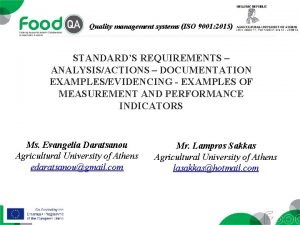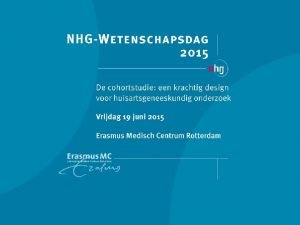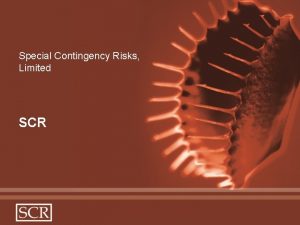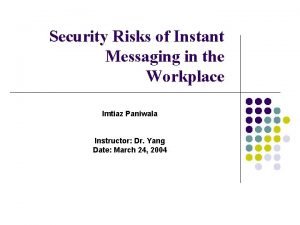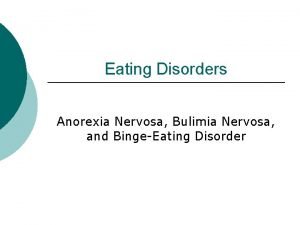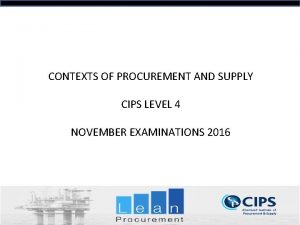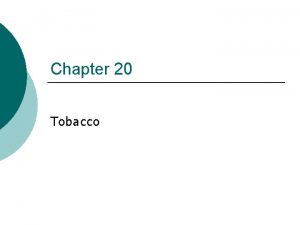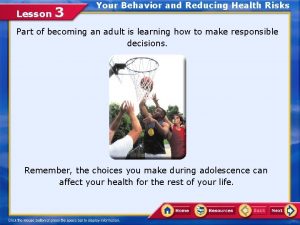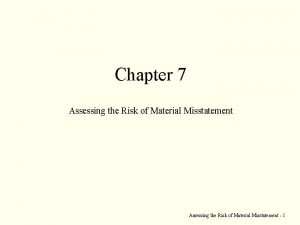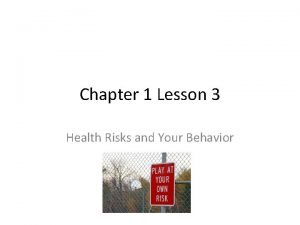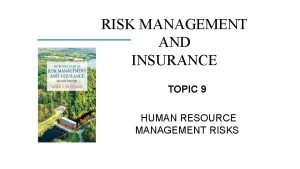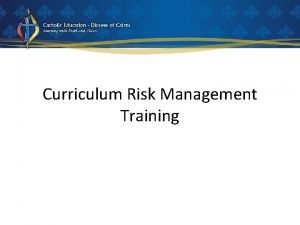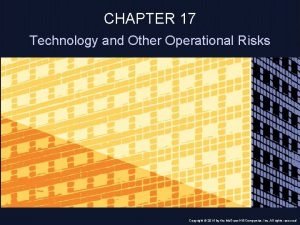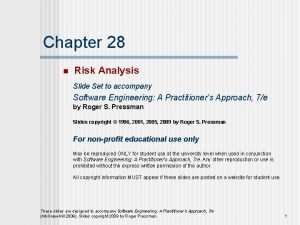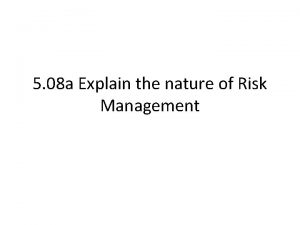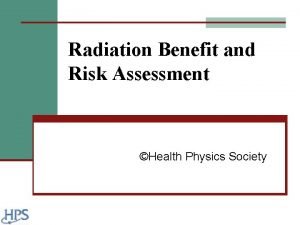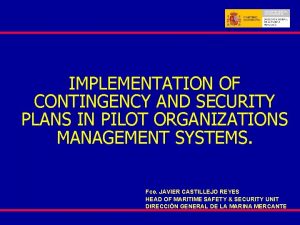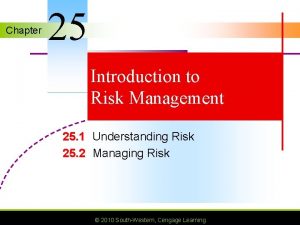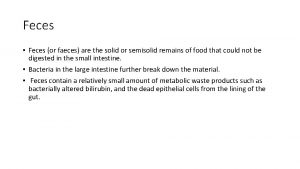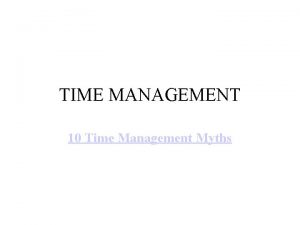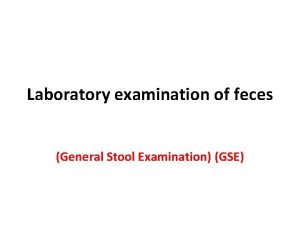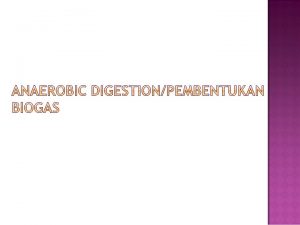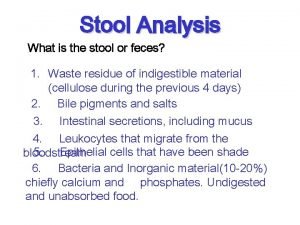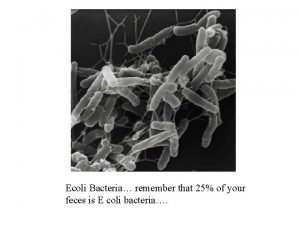Feces Management Time to Address the Risks Jim








![Reservoir Feces fe‧ces fi siz/ fee-seez] [ –noun (used with a plural verb ) Reservoir Feces fe‧ces fi siz/ fee-seez] [ –noun (used with a plural verb )](https://slidetodoc.com/presentation_image_h/db0bc7320e8f6ec05a1d6ddda9abef1b/image-9.jpg)























































































- Slides: 96

Feces Management: Time to Address the Risks Jim Gauthier MLT, CIC Providence Care Kingston, Ontario, Canada Hosted by Bruce Gamage Provincial Infection Control Network of Vancouver Teleclass Broadcast Sponsored by www. meiko. de www. webbertraining. com April 9, 2015

Disclaimer Jim has been hired as a consultant or has been sponsored as a speaker by the following companies: ◦ ◦ ◦ ◦ Meiko Steven’s Arjo. Huntleigh Virox Diversey 3 M Ecolab 2

Disclaimer None of these companies have had any influence on the content of this presentation 3

Objectives Review mode of transmission and portal of entry related to multi-drug resistant organisms (MDRO) Discuss areas in healthcare that need more attention Propose ideas for discussion 4

http: //diseasedetectives. wikia. com/wiki/Chain_of_Transmission

Infectious Agent Vancomycin Resistant Enterococci (VRE) Extended Spectrum Beta Lactamase (ESBL) Carbapenemase-producing Enterobacteriaceae (CPE) Clostridium difficile (CD) ◦ Not truly an MDRO 6

Infectious Agent Methicillin Resistant Staphylococcus aureus ◦ Yes, that bug… Ebola ◦ Yes, I know it is not an MDRO by definition 7

http: //diseasedetectives. wikia. com/wiki/Chain_of_Transmission
![Reservoir Feces feces fi siz feeseez noun used with a plural verb Reservoir Feces fe‧ces fi siz/ fee-seez] [ –noun (used with a plural verb )](https://slidetodoc.com/presentation_image_h/db0bc7320e8f6ec05a1d6ddda9abef1b/image-9.jpg)
Reservoir Feces fe‧ces fi siz/ fee-seez] [ –noun (used with a plural verb ) ◦ 1. Waste matter discharged from the intestines through the anus; excrement. ◦ 2. Also, especially British, faeces. Origin 1425 -75; late middle English from Latin faecēs – grounds, dregs, sediment *www. dictionary. com Dictionary. com unabridged V 1. 0. 1 9

Reservoir Urine ◦ Colonization common ◦ Especially elderly patients ◦ Catheterized patients 10

Reservoir Sputum ◦ Common in elderly, intubated (Garcia 2005) ◦ Not applicable to this presentation 11

http: //diseasedetectives. wikia. com/wiki/Chain_of_Transmission

Portal of Exit Defecation ◦ Formed, soft, loose ◦ www. continence. org. au (O’Donnell 1990) Urination 13

http: //diseasedetectives. wikia. com/wiki/Chain_of_Transmission

Mode of Transmission Equipment ◦ Bedpans, commode buckets, urinals, bed rails, toilet high touch surfaces Hands ◦ Staff ◦ Patients Aerosols? 15

http: //diseasedetectives. wikia. com/wiki/Chain_of_Transmission

Portal of Entry Rectum, mouth, non-intact skin Fecal – oral ◦ Who puts this into the patient’s mouth or rectum? ◦ Rectum – endoscopes, gloved hands ◦ Mouth – endoscopes, hands 17

http: //diseasedetectives. wikia. com/wiki/Chain_of_Transmission

Susceptible Host Our patients CDI ◦ Proton pump inhibitors, antibiotics, hemodialysis, HIV, numerous hospital admissions (Bengualid 2011) CRE ◦ International travel (Tängdén 2010) ◦ Unrecognized colonized patient (Borgia 2012) 19

Control Measures www. qualitysystems. co 20

Horizontal vs Vertical Infection Control Wenzel 2010 21

Horizontal Reduce rates of all infections for all pathogens Hand hygiene program Decolonization therapies (Chlorhexidine bathing) Board to ward (Nat Audit Office 2009) Antibiotic Stewardship Programs Cleaning and disinfection 22

Horizontal vs Vertical Infection Control Wenzel 2010 23

Vertical Focus on a single pathogen or anatomic site Pathogen specific ◦ MRSA ◦ VRE ◦ ESBL ◦ CRE ◦ Acinetobacter ◦ Candida 24

Modern Vertical Semmelweis Death by Group A Streptococcal puerperal sepsis ◦ Screen for Group A only? ◦ Only use an agent effective against gram positive cocci? ◦ Only wash hands if in morgue? 25

26

VRE in the Environment Grabsch 2006 Colonized and past colonized VRE patients Structured exam, hemodialysis sessions Chairs positive in 36% outpatient, 58% hemodialysis Couch positive 48% OP, 42% radiology, 27

NDM-1 Environment Walsh 2011 - New Delhi 12 of 171 seepage samples grew 2 of 50 water samples grew 11 species in which NDM-1 not previously reported Some resistance to meropenem seen in isolates 28

Survival - CRE Havill 2014 Looked at K. freundii pneumoniae and C. Water TSB K. pneumoniae 19 days 40 days C. freundii 12 days 40 days Can be shed into the environment and survive Because in GI tract, could be shed with high inoculum 29

Clostridium difficile Fekety 1980 ◦ Hands and fecally contaminated items ◦ Low infective dose in hamsters in presence of antibiotics ◦ Over 1000 cfu orally did not colonize nor infect unchallenged hamsters ◦ Looked at relationship with Lactobacilli and other gut flora 30

C. difficile Deep cleaning ◦ “…breaking the cycle of faecal-oral spread. ” ◦ Included deep cleaning (emptying ward) (Cartmill 1994) Floor Contamination ◦ Especially washrooms, sluice rooms ◦ Moved by feet hypothesized ◦ High rate of colonization in Geriatrics (Mc. Coubrey 2003) 31

C. difficile Colonization Alasmari 2014 14% on admission ◦ Toxigenic, no relation to previous admission Galdys 2014 Review article ◦ Strong evidence suggests that CDcolonized individuals are a reservoir for CD infection Donskey 2014 Review article ◦ As above. ◦ Sporicidal in all rooms potential to reduce 32 transmission

MRSA diarrhea Stools for CD testing cultured for MRSA ◦ Diarrhea and MRSA colonization of stool (Case) ◦ MRSA + patients, negative stool (Control) 10 surfaces in patient’s room 59% of case surfaces contaminated 23% of control surfaces contaminated ◦ Boyce 2007 33

Ebola 2 -4 litres of liquid stool per day ◦ Lyon 2014 34

35

Control Measures www. qualitysystems. co 36

Patient Hand Hygiene Savage 2011 36 hour observation session Patients: 151 opportunities ◦ Zero used soap or ABHR Visitors: 121 opportunities ◦ 4% soap or ABHR 37

38

Does it Work? Could not get rates down 4 full time and 4 part time attendants hired Met patients and visiting relatives at door Verbal and pamphlet Encourage to clean hands at least twice per day Used 70% with 0. 5% Chlorhexidine 39

Results Impressive 2002 -3 2003 -4 Reduction MRSA Infections per 1000 Admissions 10. 6 5. 2 51% MRSA BSI 1. 3 0. 2 85% MRSA Resp 4. 9 1. 5 69% 59% (13/22) 14% (2/14) 76% 0. 7 0. 2 71% Ratio MRSA BSI / MSSA BSI MRSA Mortality 40

Projected Savings $688, 843! May have prevented 51 infections ◦ MRSA infection ~ $14, 360 ◦ MRSA BSI ~ $27, 083 ◦ Staffing was $170, 000 41

MRSA Infections per 1000 Patient Admissions 04 -05 05 -06 06 -07 07 -08 08 -09 09 -10 10 -11 11 -12 12 -13 2. 3 1. 0 0. 6 0. 7 0. 5 0. 3 0. 2 0 Personal Communication 2013 42

Hand Sanitizer Bottle Label FOR PATIENT USE Keep on overbed table If necessary, please ask for assistance to use this product 43

44

Patient Moments Landers 2012 (review) 1. After using the toilet, bedpan, or commode 2. When returning to room after test or procedure 3. Before eating, drinking, taking medicine, or putting anything in your mouth 45

Patient Moments 4. When visibly dirty 5. Before touching any breaks in the skin (wounds, dressing, tubes) or any care procedure (dialysis, IV drug administration, injections) 6. Before dialysis, contact with IV lines or other tubes 46

Patient Moments 7. After coughing, sneezing, or touching nose or mouth 8. Before interacting with visitors and after they leave 9. When there is concern about whether hand are clean 47

Jim’s Additional Moments 1. Leaving a wheelchair - New pamphlet for patients 2. After pet therapy (Lefebvre 2006) 48

C. difficile APIC 2013 – Guide to preventing CDI Patient hand hygiene is mentioned Single use bedpan or single patient bedpan ◦ “Disposal of excreta and cleaning of the bedpan or commode should be preplanned” ◦ “An alternate is to use a single patient– use bedpan that can be cleaned with a bleach-based disinfectant after each use” 49

Preventative Measures Palmore 2013 - CRE Patients use gloves and gowns Double clean Hand hygiene (staff) Chlorhexidine baths (ICU) Adherence monitoring 50

Preventative Measures Bed cleaning Sink drains Room vapor disinfection No mention of patient hand hygiene 51

Guidelines ECDC 2011 52

European Center for Disease Control Prior antimicrobial Positive culture from use Length of stay (time at risk) Severity of illness Mechanical ventilation Admission to the ICU High procedure score Presence of wounds a blood isolate Transfer between hospital units within the same hospital Prior surgery Prior hospital stay Presence of a biliary catheter and recent transplantation 53

ECDC – Low Grade Evidence …consistently supports the effectiveness of early, active surveillance for CPE carriage by rectal screening Additional precautions for the care of CPE-positive patients, ◦ wearing disposable gloves and gown ◦ cohort nursing by a separate, dedicated team 54

ECDC – Other Measures Long Term Healthcare Facilities ◦ Israel uses contact precautions if: Patient incontinent On antimicrobials 55

2013 56

Public Health England 57

PHE Early Screening Early Isolation Reinforce Strict Standard Precautions 58

PHE No words such as ◦ Bedpan Does have language for ◦ Diarrhoea (around hand hygiene) ◦ Toilet (that patient will have a private en suite) ◦ Environment (cleaning) ◦ Commode (if no toilet) ◦ Disinfection (high touch, mattresses, endoscope, etc. ) 59

PHE Other close-patient contact equipment and items ◦ pulse oximeters, blood pressure cuffs, stethoscopes and thermometers, privacy curtains, unused wrapped single-use items in the patient’s immediate vicinity, tubes of ointment and lubricant 60

61

CDC Hand Hygiene Contact Precautions (colonized or infected) Patient and staff cohorting Minimize use of invasive devices Antimicrobial Stewardship Screening 62

CDC LTC settings high risk residents ◦ totally dependent upon healthcare personnel for activities of daily living ◦ ventilator-dependent ◦ incontinent of stool ◦ wounds whose drainage is difficult to control ◦ high-risk settings (e. g. , ventilator unit) 63

CDC No words such as ◦ Diarrhea, Toilet, Environment, Bedpan, Commode, Disinfect, patient hand hygiene Does recognize that incontinent patients in LTC should have ◦ Private room ◦ Possibly chlorhexidine bathing 64

http: //www. apic. org/For-Consumers/Monthly-alerts-for-consumers/Article? id=cre-the-nightmare- 65

Spread of CRE infection To get a CRE infection, a person must be exposed to CRE bacteria are most often spread person-to-person in healthcare settings specifically through contact with: ◦ infected or colonized people ◦ contact with wounds or stool 66

What You Can Do Now 8. When you are in a healthcare facility, insist that everyone who takes care of you clean their hands with soap and water or an alcohol-based hand rub before touching you! And remind them to wash their hands again as they leave your room! 67

CRE Guidelines Curran 2014 Confusion on terms like Standard Precautions Ensure guidelines writers understand the front line 68

Curran 2014 5 Fronts: ◦ SP for all and additional transmission based precautions for CRE ◦ Hand washing basins free of CRE ◦ Safe injection and endoscopy practices ◦ Prepare for outbreaks ◦ Antimicrobial stewardship 69

So, What do I Suggest? Monitor, or know, how many patients are incontinent ◦ Or using briefs, diapers, assistive devices Cochard 2014 – ESBL carriage nursing homes Significantly associated with ◦ Malignancy ◦ Urinary AND fecal incontinence 70

Control Measures www. qualitysystems. co 71

Suggestions Manage feces and urine better than our great grandfathers Mandate NO manual cleaning ◦ Thermal disinfection ◦ Macerators ◦ Liners ◦ Disposable 72

Suggestions When we publish, list how feces and urine is managed and by what percentage ◦ Brief ◦ Toilet ◦ Commode ◦ Thermal disinfection ◦ Macerator ◦ Liner 73

Suggestion Mandatory gown use for any contact or potential contact with feces ◦ All the time ◦ Horizontal program Sporicidal agent for all terminal cleans of washrooms (Bengualid 2011, Galdys 2014) 74

Suggestions Isolate patients with diarrhea ◦ Benjamin 2014 Any soiling of the environment with feces is an issue! 75

Suggestions – Clean! Nseir 2011 Acquisition if in bed from previous patient Siani 2011 ◦ Wipes moved spores around ◦ Issue with “sporicidal” claims Sattar 2013 ◦ Need better control of wipe use and testing Loo 2015 ◦ Clean environment and patient’s hands 76

Suggestions – Clean! Zoutman 2013 ◦ 40% of ICP’s felt hospital was NOT clean enough ◦ Frequent consultation between IPAC and Environmental Services before cleaning changes – lower CDI rates 77

Suggestions – Clean! Zoutman 2014 Less than 50% of ES managers felt they had enough staff Over 1/3 did no auditing 78

Suggestions Lids on toilets/hoppers ◦ Aerosols around toilets from flushing has been studied (Gerba 1975, Barker 2005, Johnson 2013) ◦ C. difficile was in droplets around toilets with no lids (Best 2012, Roberts 2008) ◦ Viral spread (Verani 2014) 79

Ebola Feces and vomit have virus ◦ (Shieffelin 2014, Chertow 2014) ◦ Dallas family No illness ◦ Dallas hospital 2 infected Wet Phase ◦ 2 -4 litres of liquid stool per day 80

WARNING!! This patient has: Skin! Feces! Mucous Membranes! PERFORM HAND HYGIENE AFTER CONTACT WITH THIS PATIENT OR THEIR ENVIRONMENT! 81

82

Comments? Questions? 83

References Alasmari F, Sieler SM, Hink T, et al. Prevalence and risk factors for asymptomatic Clostridium difficile carriage. Clin Infect Dis 2014; 59(2): 216 -22 American Practitioners in Infection Control and Epidemiology. http: //www. apic. org/For. Consumers/Monthly-alerts-forconsumers/Article? id=cre-the-nightmare-bacteria. Accessed November 2, 2014 American Practitioners in Infection Control and Epidemiology. http: //www. apic. org/For-Media/News -Releases/Article? id=2122443 e-6 d 22 -46 ae-aecce 9512 e 98 e 1 cb Accessed November 10, 2014 Barker J, Jones MV. The potential spread of infection caused by aerosol contamination of surfaces after flushing a domestic toilet. J Appl Microbiol 2005; 99: 339 -347 84

References Benjamin A, Rogers BA, Havers SM, Harris-Brown TM, Paterson DL. Predictors of use of infection control precautions for multiresistant gram-negative bacilli in Australian hospitals: Analysis of a national survey. AJIC 2014; 42: 963 -9 Best EL, Sandoe JAT, Wilcox MH. Potential for aerosolization of Clostridium difficile after flushing toilets: the role of toilet lids in reducing environmental contamination risk. J Hosp Infect 2012; 80: 1 -5 Bengualid V, Umesh KC, Alapati J, Berger J. Clostridium difficile at a community hospital in the Bronx, New York: Incidence prevalence and risk factors from 2006 to 2008. AJIC 2011; 39: 183 -7 Borgia S, Lastovetska O, Richardson D, Eshaghi A, et al. Outbreak of carbapenem-resistant Enterobacteriaceae containing bla. NDM-1, Ontario, Canada. Clin Infect Dis. 2012 Dec; 55(11): e 109 -17. doi: 10. 1093/cid/cis 737. Epub 2012 Sep 20. 85

References Boyce JM, Havill NL, Otter JA, Adams NMT. Widespread environmental contamination associated with patients with diarrhea and methicillin-resistant Staphylococcus aureus colonization of the gastrointestinal tract. ICHE 2007; 28(10): 1142 -7 Cartmill TDI, et al. Management and control of a large outbreak of diarrhoea due to Clostridium difficile. J Hosp Infect 1994; 27: 1 -15 Center for Disease Control and Prevention. Guidance for control of carbapenem-resistant Enterobacteriaceae (CRE). 2012 http: //www. cdc. gov/hai/organisms/cretoolkit/index. html Accessed November 10, 2014 Chertow DS, Kleine C, Edwards JK, Scaini R, et al. Ebola virus disease in West Africa – clinical manifestations and management. NEJM 2014 Nov 5, 2014 86

References Cochard H, Aubier B, Quentin R, van der Mee-Marquet N. Extended-spectrum beta lactamase-producing Enterobacteriaceae in French nursing homes: an association between high carriage rate among residents, environmental contamination, poor conformity with good hygiene practice, and putative resident-to-resident transmission. ICHE 2014; 35(4): 384 -9 Curran ET, Otter JA. Outbreak column 15: Carbapenemase-producing Enterobacteriaceae. J Infect Prevent 2014; 15: 193 -198 Donskey CJ, Kundrapu S, Deshpande A. Colonization versus carriage of Clostridium difficile. Infect Dis Clin N Am 2015; 29: 13– 28 European Centre for Disease Prevention and Control. Risk assessment on the spread of carbapenemaseproducing Enterobacteriaceae (CPE) through patient transfer between healthcare facilities, with special emphasis on cross-border transfer. Stockholm: 87

References Fekety R, et al. Studies on the epidemiology of antibioticassociated Clostridium difficile colitis. Am J Clin Nutr 1980; 33: 2527 -32 Gagné D, Bédard G, Maziade PJ. Systematic patients’ hand disinfection: impact on meticillin resistant Staphylococcus aureus infection rates in a community hospital. J Hosp Infect 2010; 75: 269 -72 Galdys AL, Curry SR, Harrison LH. Asymptomatic Clostridium difficile colonization as a reservoir for Clostridium difficile infection. Expert Rev Anti Infect Ther 2014; 12: 967– 80 Garcia R. A review of the possible role of oral and dental colonization of the occurrence of health care-associated pneumonia: underappreciated risk and a call for interventions. Am J Infect Control 2005; 33(9): 527 -40 Gerba CP, Wallis C, Melnick JL. Microbiological hazards of household toilets: droplet production and the fate of residual organisms. Appl Microbiol 1975; 30(2): 229 -237 88

References Grabsch EA, Burrell LJ, Padiglione A, O’Keefe JM, et al. Risk of environmental and healthcare worker contamination with vancomycin resistant enterococci during outpatient procedures and hemodialysis. Infect Control Hosp Epidemiol 2006; 27: 287 -93 Havill NL, Boyce JM, Otter JA. Extended survival of carbapenem-resistant Enterobacteriaceae on dry surfaces. ICHE 2014; 35(4)445 -7 Johnson DL, Mead KR, Lynch RA, Hirst DVL. Lifting the lid on toilet plume aerosol: A literature review with suggestions for future research. AJIC 2013; 41: 254 -8 Landers T, Abusalem S, Coty MB, Bingham J. Patientcentered hand hygiene: the next step in infection prevention. AJIC 2012; 40: S 11 -S 17 89

References Loo VG. Environmental interventions to control Clostridium difficile. Infect Dis Clin N Am 2015; 29: 83– 91 Lyon GM, Mehta AK, Varkey JB, Brantly K, et al. Clinical care of two patients with Ebola virus disease in the United States. NEJM 2014 DOI: 10. 1056/NEJMoa 1409838 Mc. Coubrey J, et al. Clostridium difficile in a geriatric unit: a prospective epidemiological study employing a novel S-layer typing method. J. Med Micro 2003; 52: 573 -8 National Audit Office. Reducing healthcare associated infections in hospitals in England. Report by the Comptroller and Auditor General. HC 560 Session 2008 -2009; 2009. National Audit office; London, UK 90

References Nseir S, Blazejewski C, Lubret R, Wallet F, et al. Risk of acquiring multidrug-resistant gram-negative bacilli from prior room occupants in the intensive care unit. Clin Microbiol Infect 2011; 17: 1201– 1208 O’Donnell LJD, Virjee J, Heaton KW. Detection of pseudodiarrhea by simple clinical assessment of intestinal transit rate. BMJ 1990; 300(6772): 439 -40 Palmore TN, Henderson DK. Managing transmission for carbapenem-resistant Enterobacteriaceae in healthcare settings: a view from the trenches. Clin Infect Disease 2013; 57(11): 1593 -9 Public Health England Working Group. Acute trust tooklit for the early detection, management and control of carbapenemase producing Enterobacteriaceae. 2013 PHE: London. 91

References Roberts K, Smith FC, Snelling AM, Kerr KG, et al. Aerial dissemination of Clostridium difficile spores. BMC Infect Dis 2008; 8: 7 Sattar S, Maillard JY. The crucial role of wiping in decontamination of high-touch environmental surfaces: Review of current status and directions for the future. Am J Infect Control 2013; 41: S 97 -S 104 Savage J, Fuller C, Besser S, Stone S. Use of alcohol hand rub (AHR) at ward entrances and use of soap and AHR by patients and visitors: a study in 27 wards in 9 acute NHS trusts. J Infect Prev 2011; 12: 54 -8 Schieffelin JS, Shaffer JG, Gova A, Gbaki M, et al. Clinical illness and outcomes in patients with Ebola in Sierra Leone. NEJM. org Oct 29 2014. DOI: 10. 1056/NEJMoa 1411680 92

References Siani G, Cooper C, Maillard JY. Efficacy of “sporicidal” wipes against Clostridium difficile. Am J Infect Control 2011; 39: 212 -8 Tängdén T, Cars O, Melhus A, Löwdin E. Foreign travel is a major risk factor for colonization with Escherichia coli producing CTX-M-type extended-spectrum betalactamases: a prospective study with Swedish volunteers. Antimicrob Agents Chemother 2010; 54: 3564– 8 Verani M, Bigazzi R, Carducci A. Viral contamination of aerosol and surfaces through toilet use in health care and other settings. AJIC 2014; 42: 758 -62 Walsh TR, Weeks J, Livermore DM, Toleman MA. Dissemination of NDM-1 positive bacteria in the New Delhi environment and its implications for human health: an environmental point prevalence study. The Lancet Infect Dis 2011; 11: 355 -62 93

References Wenzel RP, Edmond MB. Infection control: the case for horizontal rather than vertical interventional programs. Int J Infect Dis 2010; 14(supp 4); S 3 -S 5 Zoutman DE, Ford BD, Sopha K. Working relationships of infection prevention and control programs and environmental services and associations with antibioticresistant organisms in Canadian acute care hospitals. AJIC 2014; 42: 349 -52 Zoutman DE, Ford BD, Sopha K. Environmental cleaning resources and activities in Canadian acute care hospitals. AJIC 2014; 42: 490 -494 94

April 14 (British Teleclass) SURGICAL SITE INFECTION: A SURGEON’S PERSPECTIVE Prof. David Leaper, University of Huddersfield, UK A PRAGMATIC APPROACH TO INFECTION PREVENTION AND CONTROL GUIDELINES IN AN AMBULATORY CARE SETTING April 16 Jessica Ng, Women’s College Hospital, Toronto April 22 (South Pacific Teleclass) COMING UP ROSES – A SUSTAINABLE COLUTION TO CONTINENCE PRODUCT DISPOSAL Julianne Munroe, Christchurch Women’s Hospital, New Zealand April 30 ARE WIPES (TOWELETTES) EFFECTIVE FOR SURFACE DECONTAMINATION IN HEALTHCARE SETTINGS? Prof. Jean-Yves Maillard, Cardiff University, Wales 95

96
 Actions to address risks and opportunities
Actions to address risks and opportunities Calprotectine waarde 80
Calprotectine waarde 80 Feces
Feces Physical memory vs logical memory
Physical memory vs logical memory Cash management risks
Cash management risks For minutes. start.
For minutes. start. Hát kết hợp bộ gõ cơ thể
Hát kết hợp bộ gõ cơ thể Slidetodoc
Slidetodoc Bổ thể
Bổ thể Tỉ lệ cơ thể trẻ em
Tỉ lệ cơ thể trẻ em Voi kéo gỗ như thế nào
Voi kéo gỗ như thế nào Tư thế worm breton là gì
Tư thế worm breton là gì Chúa yêu trần thế alleluia
Chúa yêu trần thế alleluia Các môn thể thao bắt đầu bằng tiếng bóng
Các môn thể thao bắt đầu bằng tiếng bóng Thế nào là hệ số cao nhất
Thế nào là hệ số cao nhất Các châu lục và đại dương trên thế giới
Các châu lục và đại dương trên thế giới Công của trọng lực
Công của trọng lực Trời xanh đây là của chúng ta thể thơ
Trời xanh đây là của chúng ta thể thơ Cách giải mật thư tọa độ
Cách giải mật thư tọa độ Làm thế nào để 102-1=99
Làm thế nào để 102-1=99 Phản ứng thế ankan
Phản ứng thế ankan Các châu lục và đại dương trên thế giới
Các châu lục và đại dương trên thế giới Thể thơ truyền thống
Thể thơ truyền thống Quá trình desamine hóa có thể tạo ra
Quá trình desamine hóa có thể tạo ra Một số thể thơ truyền thống
Một số thể thơ truyền thống Bàn tay mà dây bẩn
Bàn tay mà dây bẩn Vẽ hình chiếu vuông góc của vật thể sau
Vẽ hình chiếu vuông góc của vật thể sau Nguyên nhân của sự mỏi cơ sinh 8
Nguyên nhân của sự mỏi cơ sinh 8 đặc điểm cơ thể của người tối cổ
đặc điểm cơ thể của người tối cổ Giọng cùng tên là
Giọng cùng tên là Vẽ hình chiếu đứng bằng cạnh của vật thể
Vẽ hình chiếu đứng bằng cạnh của vật thể Vẽ hình chiếu vuông góc của vật thể sau
Vẽ hình chiếu vuông góc của vật thể sau Thẻ vin
Thẻ vin đại từ thay thế
đại từ thay thế điện thế nghỉ
điện thế nghỉ Tư thế ngồi viết
Tư thế ngồi viết Diễn thế sinh thái là
Diễn thế sinh thái là Dạng đột biến một nhiễm là
Dạng đột biến một nhiễm là Các số nguyên tố là gì
Các số nguyên tố là gì Tư thế ngồi viết
Tư thế ngồi viết Lời thề hippocrates
Lời thề hippocrates Thiếu nhi thế giới liên hoan
Thiếu nhi thế giới liên hoan ưu thế lai là gì
ưu thế lai là gì Khi nào hổ con có thể sống độc lập
Khi nào hổ con có thể sống độc lập Khi nào hổ con có thể sống độc lập
Khi nào hổ con có thể sống độc lập Hệ hô hấp
Hệ hô hấp Từ ngữ thể hiện lòng nhân hậu
Từ ngữ thể hiện lòng nhân hậu Thế nào là mạng điện lắp đặt kiểu nổi
Thế nào là mạng điện lắp đặt kiểu nổi The biggest risk is not taking any risks
The biggest risk is not taking any risks Scr limited
Scr limited David chaffey
David chaffey Risks of e procurement
Risks of e procurement Instant messaging security risks
Instant messaging security risks Risk management in civil engineering
Risk management in civil engineering Papp-a ( fmf roche ) norma
Papp-a ( fmf roche ) norma Enterprise risk management framework for credit unions
Enterprise risk management framework for credit unions Bulimia diagnostic criteria
Bulimia diagnostic criteria Costs and risks of database approach
Costs and risks of database approach Cips procurement process
Cips procurement process Inherent risks examples
Inherent risks examples Chapter 22 lesson 1 the health risks of drug use
Chapter 22 lesson 1 the health risks of drug use Chapter 20 lesson 1
Chapter 20 lesson 1 Principles of credit risk management
Principles of credit risk management Chapter 1 lesson 3 health risks and your behavior
Chapter 1 lesson 3 health risks and your behavior Cloud computing benefits and risks
Cloud computing benefits and risks While assessing the risks of material misstatement
While assessing the risks of material misstatement Related risks that increase in effect with each added risk
Related risks that increase in effect with each added risk Owasp top 10 privacy risks
Owasp top 10 privacy risks Hr
Hr Power of media and information
Power of media and information Chapter 1 lesson 3 health risks and your behavior
Chapter 1 lesson 3 health risks and your behavior Balfour beatty 6 fatal risks
Balfour beatty 6 fatal risks Material selection risks
Material selection risks Managing risks in school curriculum activities
Managing risks in school curriculum activities Technology and operational risk
Technology and operational risk Workplace hazards and risks
Workplace hazards and risks Types of risk in international business
Types of risk in international business Data center consolidation strategy
Data center consolidation strategy Risks and mitigation slide
Risks and mitigation slide Retrospective risk
Retrospective risk Understanding hazards and risks
Understanding hazards and risks Policy risk
Policy risk Lullaby trust spot the risks
Lullaby trust spot the risks Risks digest
Risks digest Programmatic risk examples
Programmatic risk examples Risks of doing business in emerging markets
Risks of doing business in emerging markets Project finance risks and mitigants
Project finance risks and mitigants Health risks
Health risks What are market risks
What are market risks Possible risks
Possible risks Digital banking cis
Digital banking cis Lifewave antenna
Lifewave antenna Workstation domain risks threats and vulnerabilities
Workstation domain risks threats and vulnerabilities Contingecy
Contingecy Ten risk management
Ten risk management Factors that affect location decisions
Factors that affect location decisions Pure risk example
Pure risk example
